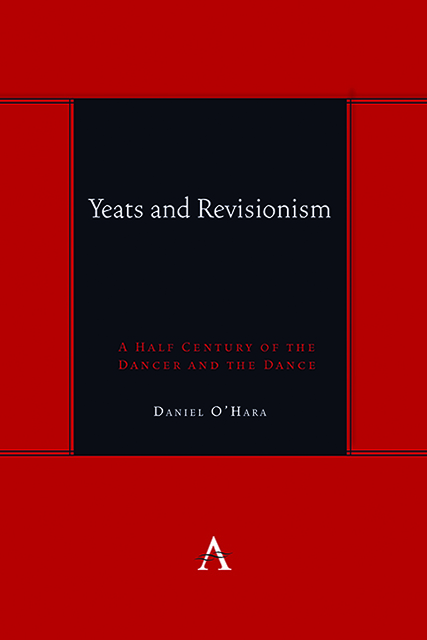Book contents
- Frontmatter
- Dedication
- Contents
- Acknowledgments
- Preface
- Introduction: Dancer and Dance: Yeats’s Romantic Modernism and Critical Revisionism
- Chapter 1 The Irony of Tradition in W.B. Yeats’s Autobiography: Dialectical Hermeneutics Beyond the New Criticism
- Chapter 2 The Specialty of Self-Victimization: On Antithetical Revisionism
- Chapter 3 Yeats in Theory: Blackmur, Bloom, De Man and Hartman
- Chapter 4 The Divisions of Yeats Studies Continued
- Chapter 5 Modernism’s Global Identity: on the Dogmatic Imagination in Yeats, Freud and Beyond
- Chapter 6 Yeats With Lacan: Toward the Real Modernism
- Chapter 7 The Spirit Medium: Yeats, Quantum Visions and Recent Lacanian Studies
- Chapter 8 And All the Ceremonies to Come: Of High Modernism, Visionary Violence and Post-Marxism
- Afterword: The Reader in Yeats
- Bibliography
- Index
Chapter 3 - Yeats in Theory: Blackmur, Bloom, De Man and Hartman
Published online by Cambridge University Press: 08 June 2023
- Frontmatter
- Dedication
- Contents
- Acknowledgments
- Preface
- Introduction: Dancer and Dance: Yeats’s Romantic Modernism and Critical Revisionism
- Chapter 1 The Irony of Tradition in W.B. Yeats’s Autobiography: Dialectical Hermeneutics Beyond the New Criticism
- Chapter 2 The Specialty of Self-Victimization: On Antithetical Revisionism
- Chapter 3 Yeats in Theory: Blackmur, Bloom, De Man and Hartman
- Chapter 4 The Divisions of Yeats Studies Continued
- Chapter 5 Modernism’s Global Identity: on the Dogmatic Imagination in Yeats, Freud and Beyond
- Chapter 6 Yeats With Lacan: Toward the Real Modernism
- Chapter 7 The Spirit Medium: Yeats, Quantum Visions and Recent Lacanian Studies
- Chapter 8 And All the Ceremonies to Come: Of High Modernism, Visionary Violence and Post-Marxism
- Afterword: The Reader in Yeats
- Bibliography
- Index
Summary
One of the more remarked but less closely pondered aspects of American critical theory over the last four or so decades is the persistent centrality of Yeats to its development. I can think of no other modern literary figure, with the possible exceptions of Stevens or Joyce, whose work has been so seminally influential. The major critical movements from the 1940s to the 1970s—New Criticism, archetypal and phenomenological criticism, and a variety of post-structuralist discourses (revisionary psychoanalytic criticism, dialectical hermeneutics and deconstruction) all owe a considerable debt to Yeats. Whether as sublime master of the concrete universal, demonic adversary of genuine Romantic visionaries, or seductive forerunner of the vertiginous interplay of self-subverting tropes, Yeats has repeatedly appeared as a representative case in point.
Belated ironic modernist or last decadent romantic: the course of Yeats’ reputation has run between these extreme positions. But in the different quests to know their own Yeats for theoretical purposes, his American metacritics, insofar as they appear to have even partially succeeded in this endeavor, have suffered strange fates. Their imaginations, whether they are of the systematic kind or not, have been brought face to face with the poverty of their own inventiveness, in a manner that resembles nothing so much as the climactic expressions of those few more sensitive protagonists in Joyce's Dubliners. As they finally confront the deadly if curiously alluring work of the spiritual paralysis then afflicting Irish culture, they become affecting instances of what they dread to behold all around them—transparent figures of paralysis fixed fast in a profound and permanent attitude of imaginative defeat, caught within the prison of the very discourses their author has devised for their epiphanic educations in the (admittedly bitter) self-knowledge of internal exile. For, in attempting to comprehend and use Yeats, his American theoretical heirs conceive designs that paralyze their imaginative developments, even as they disseminate and so perpetuate the error of proposing such undertakings as exemplary. Rather than authoring Yeats, then, their chosen poet has authored and—paradoxically if not perversely—authorized them.
- Type
- Chapter
- Information
- Yeats and RevisionismA Half Century of the Dancer and the Dance, pp. 57 - 76Publisher: Anthem PressPrint publication year: 2022



